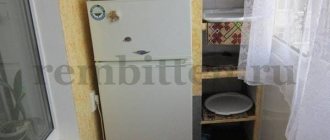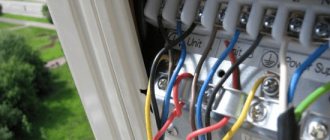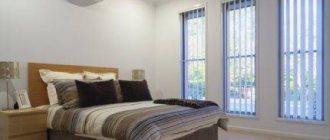The presence of a modern split system in an apartment allows you to create the most favorable living conditions: select the optimal temperature regime, adjust comfortable humidity, and filter the air. However, during the improvement process, you may encounter difficulties in installing an external unit on the facade, and an internal one in the room. Let's try to figure out how to install air conditioning on the balcony if there is no other way out.
What does a split system consist of?
Before turning to the installation features, let’s remember what parts the household appliance consists of. The air conditioner design consists of two separate blocks, one of which is mounted indoors, the second is fixed outside - on the facade of the house. The modules are connected to each other by a line of copper freon tubes and electrical wires.
The principle of operation of the split system
Cooling or heating of the air in a room is carried out by moving refrigerant through the tubes, which passes from the liquid phase to the gaseous phase (and vice versa), absorbing or giving off heat.
According to manufacturers' recommendations, the evaporator (indoor unit) is most often installed on the wall under the ceiling, where the air temperature reaches its maximum. Another important condition is installation next to the outer wall of the room, so that the distance to the remote module is minimal. The outer part is mounted on the facade, and the installation process is regulated by the requirements of SNiP 2.04.05-91* (as amended).
Window sill installation
As a rule, all window sills are standard in width and length, with a small margin for correction. For non-standard window sizes, window sills are made to order. If loggia space allows, we install a wide window sill. You can later put something on it, for example, flower pots or books. The space under the window sill can also be put to good use by installing built-in cabinets, or you can arrange a workplace.
We think in advance about what the space under the window will be like. Either we install the frame of the cabinet, or we finish the balcony along the ledge of the window sill. We prepare the base by clearing it of dust and filling all voids with foam. We cut the tabletop to the size of the window so that it fits under the slopes by about one centimeter. Then the window sill is installed on the plastic windows on the balcony; if necessary, wooden wedges are placed. We level the surface with a level, with a slight slope of up to 10 millimeters. This will prevent moisture from getting under the base of the window.
The window sill board can be fixed in several ways:
- Polyurethane foam.
- Cement mortar.
- L-shaped brackets.
- Spring brackets. They are attached to the profile under the window, and the bracket firmly presses the window sill to the window.
- If you lean the window sill directly against the window frame, then an adhesive mixture is applied under the base of the board. And the joint with the window is sealed with sealant.
When all the work is done, the cracks are sealed with foam, we place a weight of about 10 kilograms on the tabletop, check the slope of the surface and leave it to dry.
Reasons for installing blocks on the balcony
The realities of life are such that it is not always possible to follow the wishes of manufacturers. For example, there are legal grounds prohibiting the installation of an external module on the facade of a house:
- air conditioning equipment disrupts the appearance of the exterior of a residential or office building;
- the house is a historical or architectural monument;
- The external walls of the building are not suitable for the installation of heavy structures due to dilapidation, construction technology or other reasons.
In order not to use the facades, the remote air conditioner unit is placed on the balcony, and both open and glazed views are equally actively used.
Installation option inside a glazed structure
>
This way out has a number of advantages:
- easier and less expensive installation process;
- the housing is protected from external negative factors (hurricane wind, ice fragments falling from the roof);
- the distance between the parts of the air conditioner is reduced;
- simplifies equipment care - maintenance, cleaning, repair work.
There are also disadvantages to installing an air conditioner unit on a balcony, especially if glazing has already been done. You will have to take care of the forced removal of used air and always be prepared to turn off the equipment due to overheating (usually at +45 °C a protective auto-shutdown occurs). Two more troubles are associated with discomfort for residents: the bulky and heavy module body takes up a lot of space, and it produces quite loud noise, from which plastic double-glazed windows are unlikely to save.
Choosing a location for the outdoor unit
When choosing a location for an external unit, it is important to adhere to a number of rules:
- On an unglazed balcony you can place the device inside.
- The outer element is usually installed on a parapet. At the same time, it must withstand a weight of at least 80 kg.
- An excellent solution is installation on the side of the parapet. Thanks to this, the design will not spoil the appearance of the building.
- The best solution would be to place the external unit on the non-sunny side.
- The noise of the fan should not cause discomfort to neighbors.
- The fan should not be blown by the wind.
- Do not place the device near trees. In this case, leaves may get into the ventilation holes and damage the device.
- It is imperative to provide proper condensate drainage.
When installing an air conditioner, moisture should not reach the façade of the building. If you cannot drain the water into the sewer, you will have to use a special container.
Is it possible to install an air conditioner on a closed balcony?
In principle, the very installation of climate control equipment not on a permanent structure and in an enclosed space is already a violation of safety regulations. The recirculation process requires free access of air. If, nevertheless, the solution to installing an external air conditioner unit on the balcony remains the only possible one, take care of the conditions in which the equipment would operate without overloads and breakdowns.
Unprofessional installation can lead to equipment overheating and low efficiency
With an open-type balcony, everything is simple: the air conditioner has full access to fresh air, does not overheat, and therefore is able to work at full power. If the block is mounted inside a glazed structure, it is necessary to place it opposite the open sashes and make sure that they are not accidentally closed. If the air conditioner housing is installed on a parapet, a hole should be made in the casing to ensure recirculation.
>
Those wishing to secure equipment weighing 55-80 kg on the railing should be aware that SNiPs prohibit hanging any objects weighing more than 30 kg. Therefore, home craftsmen who have not received approval from management companies often install additional supports, weld brackets on the outside, install equipment at their own risk, and then pay fines. If it is possible to avoid hanging on a fence, then it is better to use it.
Common violation of generally accepted norms
One more point related to prohibitions. Balcony slabs often wear out faster than facades and even roofs. If the level of wear reaches 50%, then neither air conditioning, nor old heavy furniture, nor even double-glazed windows can be installed.
According to SNiP standards, the owner of the property is responsible for the balcony, as well as for the equipment placed on it. If safety standards are violated and someone else’s property or people are damaged as a result of falling equipment, fire or other trouble, the owner will be liable under a criminal article.
Acceptable installation on a solid wall
Thus, it is possible to install an air conditioner on a balcony if the installation does not contradict the standards and official approval has been obtained.
Economic benefits of purchasing real estate without balconies
Practical advice for those who want to sell an apartment in any housing stock without the opportunity to use a balcony will help sell the property and get the desired amount for square meters in Sochi
If, taking into account all the parameters, the buyer considers the apartment as a convenient option for him in terms of square footage, layout and location, he will not pay attention to the lack of a balcony. An apartment without this usual component has a lot of economic advantages:
- this important part of the property will not have to be glazed; over time, the old glazing will not have to be replaced with new packages;
- the amount of repair work in the apartment related to putting things in order on the balcony and keeping it properly clean will automatically decrease;
- there will be no need to install structures protecting against unauthorized entry in an apartment located on the first or last floor;
- there will be no need to buy furniture, which is usually installed on the balcony to store various things, which will reduce additional costs.
In addition, apartments without balconies are much easier to sell if they are located on the ground floor and are planned to be used for commercial space.
If you are buying real estate in a new fund, then such a purchase should be regarded as a profitable and long-term investment. The ability to leave your apartment for fresh air in this case can be considered a secondary characteristic that does not determine the choice. It’s quite hot in Sochi in the summer, so it’s much more comfortable to admire the views from panoramic windows in an air-conditioned room. The balcony as such is irrelevant, since being in the scorching sun is uncomfortable.
Unit Installation Instructions
Let's consider the most rational options for installing split systems, when the equipment cannot cause harm to either the apartment owners, passers-by, or neighbors. Work should be carried out taking into account the manufacturer’s recommendations, otherwise the equipment will quickly fail.
Option #1: installing an outdoor unit
Most often it is necessary to install an air conditioner on a glazed balcony of a cold or warm type. In the second case, in addition to the standard double-glazed structure, the balcony is insulated on all sides with heat-insulating material and lined with wooden clapboard or plastic. Thick walls with thermal insulation make it difficult to organize openings for air inlet or intake.
In order not to go against the standards and rules, installation should be done on the floor. It is better to use one of the corners so that a hole can be cut in the wall of the balcony to the size of the air conditioner. To prevent noise from operating equipment from penetrating into living spaces, the housing must be enclosed in a sealed box with an opening lid or door (for maintenance).
Transparent glass box
Thus, you can partially compensate for the disadvantages of installing an outdoor air conditioner unit on the balcony:
- a solid base, unlike brackets on the fence, ensures 100% reliability;
- fresh air circulates freely;
- due to the absence of one wall, the device does not overheat;
- the noise becomes almost inaudible;
- The usual temperature regime is maintained on the loggia or balcony.
The only inconvenience is the dimensions of the box, which will take up part of the usable area.
Installation is carried out in the following sequence:
- Prepare a place for installing an external remote unit. To do this, make a hole in the wall large enough to allow air to circulate freely. To place the body, it is better to weld (fasten to anchors) two U-shaped metal supports from the corners.
- Install the outdoor module on stands (it looks like it stands on 4 legs). Supports are necessary for shock absorption and additional air circulation.
- Mount the box. Boards, plywood sheets, galvanized steel, thick plastic or tempered glass are suitable for its manufacture. It is better to make the walls of the box multi-layered to create good sound insulation. The more airtight the casing, the more comfortable the apartment residents will feel.
- Holes are drilled in the wall with the adjacent room and in the box for connecting lines.
- They install freon tubes and electrical cables connecting the indoor and outdoor modules.
To prevent communications from being visible, they must be covered with a wide plastic cable channel. It is better to make the upper or side part of the box in the form of a hinged door that slides to the side or is completely removable so that, if necessary, repairs can be made or parts can be cleaned.
Hinged door for technical work
After testing the operation of the split system for 2-3 days, it will become clear how efficiently the equipment operates and whether additional noise insulation work is needed.
Option #2: installing an indoor unit
>
Sometimes it happens that an internal evaporation module is placed on the balcony, which should provide a comfortable microclimate directly in the living room - bedroom, living room, office or nursery. The reasons are varied: it does not meet the requirements of interior design, there is no free space, there is a risk of small children catching a cold, etc.
The optimal place for mounting the module is directly opposite the door, at a height of 1.8-2 m. If the air coming out from under the device’s blinds does not reach the room, the coolness will be felt more on the balcony. In addition, with such an arrangement of equipment, the door must always be open, otherwise the split system will again only cool the balcony.
There is no point in installing an evaporation unit on the end wall of a loggia, which is made of concrete or brick. The air will circulate freely inside the loggia, and only a small part of it will enter the room. Therefore, it will have to be somehow attached near the glazed part, consisting of glass/plastic or glass/aluminium.
Incorrect location - low efficiency
Stained glass structures will not withstand the weight of the module, and such an arrangement will not look aesthetically pleasing, so for the block it is necessary to create a suspended structure from brackets. One of the options is two suspensions made of a metal profile, the second is a perforated shelf.
Installation instructions:
- Suspensions are made from a metal profile, corner or strips, then they are mounted to the ceiling - a concrete slab.
- Install the evaporation module so that the blinds are directed towards the doors.
- Provide electrical power (install an outlet or organize cable laying from the room).
- Connect the fittings and cables leading to the outdoor unit.
- Check the operation of the equipment.
Please note that the temperature in the room will not correspond to the specified parameters, since the coverage area will increase due to the area of the balcony. Perhaps for the same reason you will have to buy an air conditioner of greater power than originally planned.
The only advantage of such an installation is the reduction in the distance from the internal module to the external unit located on the facade. The best option is to install the indoor air conditioner unit in a room with a balcony, and not outside it.
Advantages and disadvantages of such a solution
Air conditioning on a loggia has a number of advantages. These include the following:
- the outdoor unit does not interfere with neighbors;
- the device is not exposed to sunlight or precipitation;
- there is no possibility of mechanical damage to the block;
- there is free access to the unit’s systems - this allows you to easily clean it and carry out other necessary work;
- the length of the highway decreases;
The costs of installing the device are noticeably reduced - this is due to the absence of the need to perform expensive high-altitude work to secure the unit.
However, it is not always possible to install the device in this way.
The key disadvantages of this option include the following:
- It is better to place the outdoor unit on a balcony without glazing - this is due to the need for constant air flow;
- if you hang an external system on a glazed balcony, the windows must be kept open at all times - if the system overheats, it may turn off;
- noise from fans can be heard inside living rooms;
- the balcony space that can be used is reduced - this is due to the large dimensions of the external element.
When fixing the external elements of split systems, it is important to remember that they cannot be attached flush to the side walls, ceiling or floor. This will lead to overheating of the device and its rapid breakdown.
What mistakes should you avoid?
The biggest mistake is the wayward installation of the outdoor unit. If there are installation standards or prohibitions imposed by city authorities or the management company, you must first familiarize yourself with them. In case of violation, you will have to not only pay a fine, but also dismantle the equipment yourself.
Also, you should not install an outdoor unit in a glazed loggia with constantly closed or insufficiently open windows - the equipment will fail prematurely due to regular overheating. An incorrectly selected location for installing the indoor module will result in the split system running idle, cooling the air on the balcony and outside, rather than in the room.
If the air conditioner is installed to cool the loggia, then any wall will do
Often mistakes are made when arranging brackets for modules. If vibration occurs during operation, this must be provided for: install shock-absorbing pads, use only strong metal brackets that can support the weight of the unit. It is necessary to monitor the fasteners: constant vibration may cause the nuts to loosen over time.
About air conditioners
Modern air conditioners come in different types.
- A split system is the most common and popular type of air conditioner. It includes an indoor and outdoor unit.
Three components of a split system
The internal part of the system is located anywhere in the room, it operates silently and is controlled remotely.
The outer part of the system compresses the freon and transfers it to the inner part. Warm air from the condenser of the indoor unit is blown by a fan. The outdoor unit is hung outside the room, it is very bulky and noisy.
- Window system is a type of air conditioner installed in the window opening. The models are easy to install, but they are not in great demand because they are bulky, darken the room and make a lot of noise. This type of air conditioner is convenient for use in enterprises and institutions.
- A mobile system is a type of air conditioner that can be easily moved from room to room. To work, just connect to the power supply and take the drain hose outside. Such models are not widely used due to noise and small cooling capacity.
Video tips for installing an air conditioner on a balcony
A box with thermal insulation is a rational way out of the situation:
An installation option in which the windows will always have to be kept open and the door closed:
What does it look like to attach an external block to a balcony railing:
>
There are indeed many restrictions for non-standard installation of a split system, so even before purchasing the equipment, it is better to ask whether it is possible to install an air conditioner on a balcony or loggia. If any regulations contradict your plans, look for another way out - to do this, consult with engineers or representatives of the management company.
YOU MAY ALSO BE INTERESTED
Disadvantages of a warm loggia
Large weight of the structure. Before work, you must consult with a specialist and obtain permission to insulate the balcony. Some loggias are too fragile to install any structures. This is especially true for old buildings, where the future equipment of balconies was not envisaged. In addition, over time, balcony slabs wear out. It will be necessary to install an additional structure to make it possible to insulate the loggia.
High price. Materials, work of professionals, installation of the structure, installation of plastic windows - all this will cost a large amount. You can choose a budget option, but this will have little effect on the overall cost. In addition to construction work, you will have to pay for the design and arrangement of small details. Electricity costs will increase, as it is necessary to install warm electric floors. This will greatly affect the energy consumption of the entire apartment.
Reducing the area on the balcony. The loggia does not have a wide space, and after construction work, it will be even smaller. Insulating a balcony involves “building up” the walls; the additional layer will take at least 20 cm. As a result, the new room may not be very spacious. Opening window shutters reduce space in the room.
Reducing transmitted light. Since you will have to install thicker double-glazed windows, they will muffle the sunlight. To feel comfortable on the balcony, you need to think about additional lighting, which will also affect costs. However, the difference will not be so noticeable; after some time, the human eye will get used to the new lighting.
Cold neighbors' balconies. Most residents do not want to insulate their loggias due to the high cost and other disadvantages
When designing, it is important to take into account that there are cold neighbors’ balconies around, which will take away heat. This will also incur additional costs.
Panoramic windows
This drawback applies to newly built houses, in which a panorama is most often installed. In this case, it is necessary to tint the lower part of the windows so that passers-by from the street do not see the home. Personal space must be inviolable.
How and which air conditioner to choose
Installing an air conditioner on a balcony (loggia) has some important nuances, and therefore you need to select climate control equipment taking into account all the conditions. The efficiency of the device directly depends on the power, and if the device will operate in a glassed room, then it is better to choose a device that is a little more powerful.
To correctly calculate power, there is a formula according to which, with an average ceiling of 3 m, every 10 m2 of room requires 1 kW of power. Taking into account the fact that the external unit will constantly be in hot air (even if the windows are always open), it is better to take a slightly more powerful model.
Window system
For example, if the room is 15 m2, then it is recommended to take model 5, but when installing on a balcony it is better to take 7. For 20 m2, 7 is enough, but you will have to install model 9 to avoid overheating. And so on.
Attention! Additional functions should be selected according to the needs or desires of the residents; the device was originally created to cool the room. Additional functions are not always necessary, and often simply increase the cost of the device.
Basic installation rules
The remote unit of the system is installed only outside if the balcony is glazed, and the installation site is prepared in advance for reasons of convenience for subsequent maintenance.
Before installing the unit, a number of installation works must be completed:
- when the balcony structure is quite old, it is necessary to strengthen it;
- the external block has a significant mass, which sometimes reaches the weight of an average person, so the metal parapet must be strengthened;
- install brackets and firmly secure them to the parapet;
- Shock absorbers are installed between the block and the base of the mounting structure, which dampen vibration of the equipment and reduce the noise impact from its constant operation; in addition, sound insulation is installed inside the balcony cladding;
- if the balcony roof does not cover the block, then it is necessary to install a protective canopy made of durable material over it;
- the plastic pipe for condensate removal is mounted in such a way as not to cause trouble to the neighbors below.
Any air conditioning system must operate for a long time without failures, therefore, when installing it, it is necessary to take into account all the design features of the installation site, follow the rules and listen to the advice of professionals.
In what cases can you not bet
There is a limitation when it is not possible to install equipment indoors. The installation ban is issued by the management company if the house is of cultural or other value, and the presence of an air conditioner on the facade will disrupt its appearance.
The solution to the problem in this situation is installation inside the balcony, but you will need to take into account the following rules:
- According to safety regulations, at least 3 windows must be open during operation of the air conditioner, and one of them must be located opposite the structure;
- on the balcony there should be a forced removal of warm air and a system to increase the power of the air conditioner, since the creation of equipment does not take into account the heat inflows affecting the room through the glass.











